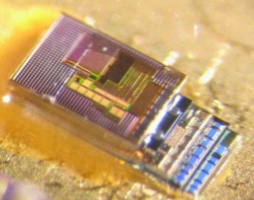Gyouho Kim awarded Rackham Predoctoral Fellowship for research in ultra-low power optical interfaces for mm-scale wireless sensor nodes
“We designed an ultra-low power optical wake-up receiver with a novel front-end circuit and communication scheme suitable for miniature wireless sensor node applications.”

 Enlarge
Enlarge
Gyouho Kim, a graduate student in the Electrical Engineering program, received a Rackham Predoctoral Fellowship to support his research while he completes his dissertation entitled, Ultra-Low Power Optical Interfaces for Nearly Invisible Cubic-Millimeter Wireless Sensor Nodes. The Rackham Predoctoral Fellowship is awarded to outstanding doctoral candidates in the final stages of their program who are unusually creative, ambitious and risk-taking.
Millimeter-scale wireless sensor nodes (WSNs) must operate on mininal battery power, which creates major design challenges in these tiny devices. Radio tranceivers are needed to extract and decode incoming information, and they are power hungry components. Since many types of WSNs only need to take sensor readings periodically, it makes sense to leave these components turned off until they are needed. Wake-up receivers are often placed on sensor nodes to detect when information needs to be recovered, at which time they “wake up” the main transceiver. Mr. Kim’s research focuses on the wake-up receiver, and he built a device that consumes significantly less power than currently available devices.

 Enlarge
Enlarge
“Since the wake-up receiver remains on at all times,” says Gyouho, “its standby power must be minimized. We designed an ultra-low power optical wake-up receiver with a novel front-end circuit and communication scheme suitable for miniature wireless sensor node applications. Named “FLOW” for Free-space Low-Power Optical Wake-up, the receiver was fabricated in 180nm CMOS, and consumes 695pW in standby mode, which is ~6,000× lower than previously reported RF and ultrasound wake-up radios. In active mode, it consumes 140pJ/bit at 91bps. A pulse width modulated communication encoding scheme is used, and chip-ID masking enables selective batch-programming and synchronization of multiple sensor nodes.”

 Enlarge
Enlarge
Mr. Kim also proposed a CMOS image sensor with ultra-low power in-pixel motion detection. Such a device is valuable in WSNs that are deployed for applications that require images, such as military surveillance and in vivo molecular imaging. “Conventional motion detection schemes use digital signal processing, with prohibitive power consumption levels for mm3-scale sensor nodes,” explains Kim. “We designed a 128×128 CMOS imager with ultra-low power in-pixel motion detection. The 130nm test chip consumes 467nW while performing motion detection, marking two orders of magnitude reduction over prior art. Full-frame images with 38.5dB dynamic range are captured at 6.4fps while consuming 16μW.
Gyouho Kim is advised by Prof. David Blaauw and Prof. Dennis Sylvester.

 MENU
MENU 
